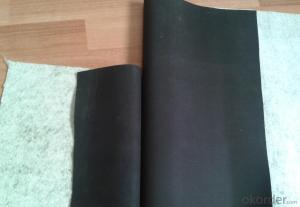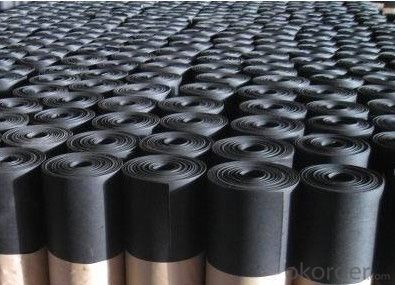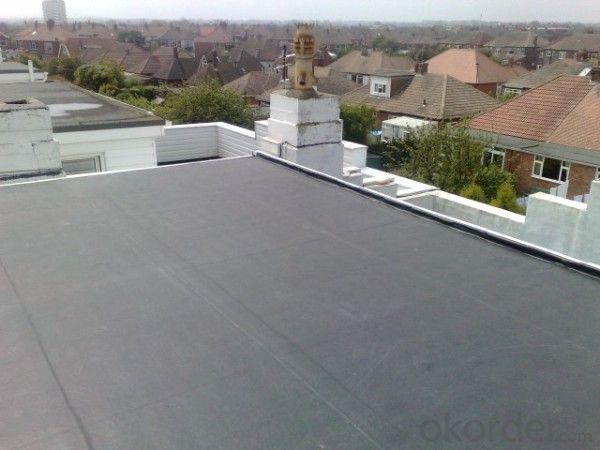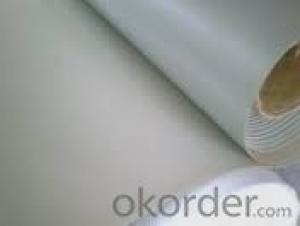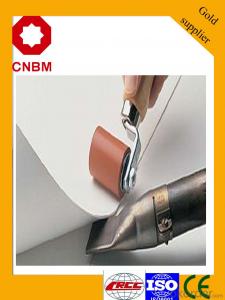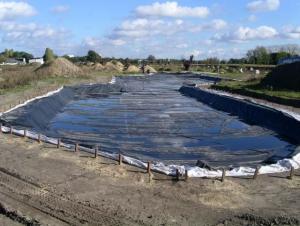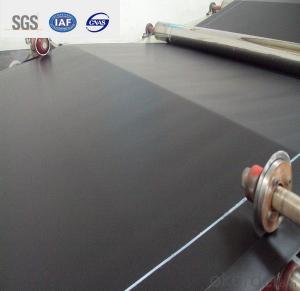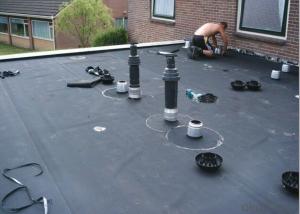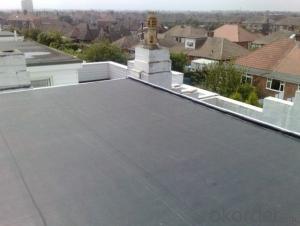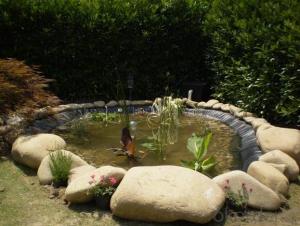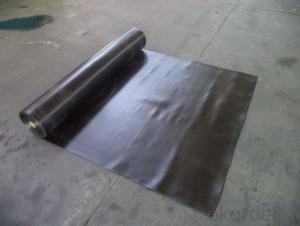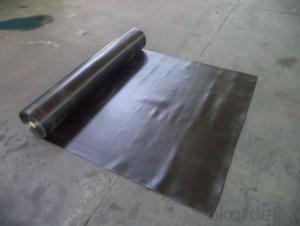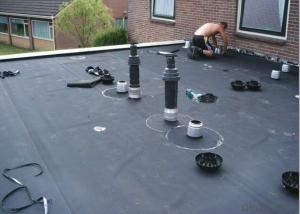EPDM Coiled Rubber Waterproof Membrane with Special Treatments
- Loading Port:
- Shanghai
- Payment Terms:
- TT OR LC
- Min Order Qty:
- 50000 m²
- Supply Capability:
- 5000000 m²/month
OKorder Service Pledge
OKorder Financial Service
You Might Also Like
EPDM Coiled Rubber Waterproof Membrane with Special Treatments
Description Of EPDM Coiled Rubber Waterproof Membrane with Special Treatments:
1. EPDM waterproof membrane is made from ternary ethylene-propylene rubber, which is for waterproofing of exposed and non-exposed applications.
2. EPDM waterproof membrane production adopts the world-advanced equipment of cold feeding extrusion and continuous vulcanization technology.
3. EPDM waterproof membrane is of high elasticity among high polymer waterproof materials and becomes a world-popular waterproofing material.
Main Features of EPDM Coiled Rubber Waterproof Membrane with Special Treatments:
1. Excellent physical and mechanical performance
2. High tearing resistance
3. Good deformation adaptability
4. High puncture resistance
5. High aging resistance
6. UV resistance
Specifications of EPDM Coiled Rubber Waterproof Membrane with Special Treatments:
| Material | EPDM Rubber |
| Size | 1.2m (width)*20m (length) or customized, weldable type 2.05m or 4m width |
| Thick | 1.2mm, 1.5mm, 2.0mm |
| Type | Vulcanized & Weldable |
| Pattern | Non-reinforced (homogeneous) |
| Certificate | ISO9001/14001 |
Applications of EPDM Coiled Rubber Waterproof Membrane with Special Treatments:
1. The substratum should be smooth, dry, clean, which can not have loosing and peeling phenomena.
2. Before application, clean up the basic level and eradicate the impurities.
3. Spread out the membrane on the substratum to loose sheet's stress. Use adhesive-glue to paint the substratum and the surface of membrane. When the adhesive is not sticky to hands, pave and press smoothly.
4. When pave the second volume of membrane, extrude 100mm of the edge of overlap of the first roll and do not paint with the adhesive. Pave the membrane on the substratum according to step so as to finish the whole pavement. When paving, do not tighten the waterproof membrane violently.
5. After that, use the special solvent to scrub the overlap joint. When it becomes fully dry , use the sheet glue to paint the both sides of the joint. Paint it again when it gets completely dry. Till the adhesive is not sticky to hands, press it smoothly and solidly.
6. Pay attention to fire prevention during application. Basement construction site shall be equipped with ventilation facilities



IMages of EPDM Coiled Rubber Waterproof Membrane with Special Treatments:




FAQ of EPDM Coiled Rubber Waterproof Membrane with Special Treatments:
1. What are we supplying?
We are specialized in producing Colorful Asphalt Roof Shingle, SBS/APP modified bitumen waterproof membrane, Self adhesive bitumen waterproof membrane, PVC waterproofing membrane, EPDM rubber roofing membrane, Single Component Polyurethane Waterproof Coating, and Spray Polyurea Waterproof Coating
.
2. How Many years experience do we have?
We have been exported to more than 20 countries in the past 15 years.
3. How long do we usually reply your request?
We always reply our customer within 24 hours.
- Q: Are waterproofing membranes resistant to UV rays?
- Yes, waterproofing membranes are designed to be resistant to UV rays. UV rays from the sun can degrade and damage many materials over time, including certain types of waterproofing membranes. To prevent this, manufacturers often incorporate UV stabilizers into the membranes during the production process. These stabilizers help to protect the membrane from the harmful effects of UV rays, such as fading, cracking, and deterioration. Additionally, some waterproofing membranes may have an outer layer or coating that provides an extra layer of UV protection. However, it is important to note that the level of UV resistance can vary depending on the type and quality of the waterproofing membrane, so it is advisable to consult the manufacturer's specifications and recommendations for the specific product being used.
- Q: Can a waterproofing membrane be removed or replaced if necessary?
- Yes, a waterproofing membrane can be removed or replaced if necessary. The process involves carefully removing the existing membrane and replacing it with a new one to ensure effective waterproofing.
- Q: Can waterproofing membranes be used on retaining walls?
- Yes, waterproofing membranes can be used on retaining walls. Waterproofing membranes are commonly used on retaining walls to prevent water infiltration and protect the structure from moisture-related issues such as seepage, efflorescence, and cracking. These membranes act as a barrier that prevents water from penetrating the retaining wall and causing damage. They are typically installed on the exterior side of the retaining wall, providing an additional layer of protection against water intrusion. Waterproofing membranes come in various forms, such as sheet membranes, liquid-applied membranes, and cementitious coatings, and can be chosen based on the specific needs and requirements of the retaining wall.
- Q: Does a waterproofing membrane require any special considerations for installation in earthquake-prone areas?
- Yes, a waterproofing membrane does require special considerations for installation in earthquake-prone areas. In these areas, the ground is more susceptible to movement and shaking, which can significantly impact the integrity of the waterproofing system. Therefore, it becomes crucial to take additional precautions to ensure that the membrane is properly installed and capable of withstanding seismic activity. One important consideration is the selection of the waterproofing membrane itself. It is recommended to choose a membrane that has been specifically designed and tested to withstand seismic activity. These membranes are usually more flexible and have higher tensile strength to accommodate ground movement during earthquakes. Additionally, the installation process should be executed with utmost care and attention to detail. The membrane should be properly anchored or secured to the substrate using appropriate fasteners and adhesives. Reinforcement techniques such as the use of reinforcing fabric or mesh can also be employed to enhance the membrane's resistance to movement. Furthermore, it is essential to ensure that all seams and joints in the membrane are properly sealed and reinforced. Special attention should be given to areas that are more prone to movement, such as corners, edges, and penetrations. Using compatible and high-quality sealants or adhesives will help maintain the integrity of these vulnerable points. Regular inspections and maintenance are also crucial in earthquake-prone areas. Inspecting the membrane periodically for any signs of damage, such as cracks or separations, allows for early detection and timely repairs. Additionally, it is vital to have a contingency plan in place to address any potential damage that may occur during an earthquake, including emergency repair procedures. In summary, installing a waterproofing membrane in earthquake-prone areas requires careful consideration and adherence to specific guidelines. By selecting an appropriate membrane, properly anchoring and reinforcing it, ensuring proper sealing of seams and joints, and conducting regular inspections, the waterproofing system can be better prepared to withstand earthquakes and provide long-lasting protection against water intrusion.
- Q: Waterproof basement is empty shop or full shop
- A waterproof, full of sticky. Secondary, sticky or sticky. Construction waterproof with waterproof material.
- Q: Can a waterproofing membrane be used for a shopping mall?
- Indeed, a waterproofing membrane is suitable for the application in a shopping mall. Due to its multiple levels and extensive surface area, a shopping mall is prone to water infiltration from various sources such as rain, plumbing leaks, and others. By incorporating a waterproofing membrane, one can effectively safeguard the structure and its contents against water damage. Typically, this membrane is installed on the exterior walls, roofs, and foundation of the shopping mall to establish a barrier against moisture penetration. Acting as a protective layer, it effectively prevents water from seeping into the building, thereby minimizing the risk of structural deterioration, mold growth, and related problems. Moreover, a properly installed waterproofing membrane can also augment energy efficiency by reducing heat loss and preventing water-induced deterioration of insulation materials. Thus, employing a waterproofing membrane is a prudent decision to ensure the long-lasting durability and functionality of a shopping mall.
- Q: Does a waterproofing membrane require any specific cleaning or maintenance procedures?
- Yes, a waterproofing membrane does require specific cleaning and maintenance procedures. Regular cleaning of the membrane surface is necessary to remove any dirt, debris, or organic materials that may accumulate over time. It is recommended to use mild soap or detergent and a soft brush or sponge for cleaning. Additionally, periodic inspections should be conducted to check for any damage, cracks, or leaks in the membrane, which should be promptly repaired. Regular maintenance and proper care are crucial to ensure the long-term effectiveness and durability of the waterproofing membrane.
- Q: Are there any specific considerations for installing a waterproofing membrane on masonry surfaces?
- Yes, there are several specific considerations for installing a waterproofing membrane on masonry surfaces. Firstly, it is important to ensure that the masonry surface is clean and free from any dirt, debris, or loose materials that could compromise the adhesion of the membrane. Additionally, the surface should be properly prepared by repairing any cracks, holes, or damaged areas before applying the membrane. The type of waterproofing membrane chosen should be compatible with masonry surfaces and be able to withstand the movement and expansion that can occur. Proper installation techniques, such as ensuring sufficient overlap and proper sealing of joints, are also crucial to ensure effective waterproofing. Lastly, regular inspections and maintenance should be conducted to identify any potential issues and address them promptly.
- Q: Can waterproofing membranes be used on concrete floors?
- Yes, waterproofing membranes can be used on concrete floors. Waterproofing membranes are commonly used in construction to prevent water penetration and protect the underlying structure. When applied to concrete floors, these membranes create a barrier that prevents water from seeping through and causing damage. Waterproofing membranes can be particularly useful in areas such as basements, bathrooms, and outdoor patios where water exposure is common. They help to maintain the integrity of the concrete floor and protect it from moisture-related issues like cracking, spalling, and mold growth.
- Q: Is a waterproofing membrane resistant to saltwater or salt damage?
- Yes, a waterproofing membrane is typically resistant to saltwater or salt damage. Waterproofing membranes are designed to provide a barrier against water and moisture, and they are commonly used in various applications where exposure to saltwater or salt is expected, such as in marine environments or near coastal areas. These membranes are often made from materials that are specifically formulated to withstand the corrosive effects of saltwater or salt. Additionally, the installation of a waterproofing membrane includes proper preparation and sealing techniques to ensure its resistance to saltwater or salt damage. However, it is important to note that the specific resistance of a waterproofing membrane to saltwater or salt damage may vary depending on the type and quality of the membrane used. Therefore, it is recommended to consult with a professional or manufacturer to ensure the appropriate membrane is selected for the specific application and environment.
Send your message to us
EPDM Coiled Rubber Waterproof Membrane with Special Treatments
- Loading Port:
- Shanghai
- Payment Terms:
- TT OR LC
- Min Order Qty:
- 50000 m²
- Supply Capability:
- 5000000 m²/month
OKorder Service Pledge
OKorder Financial Service
Similar products
Hot products
Hot Searches
Related keywords
